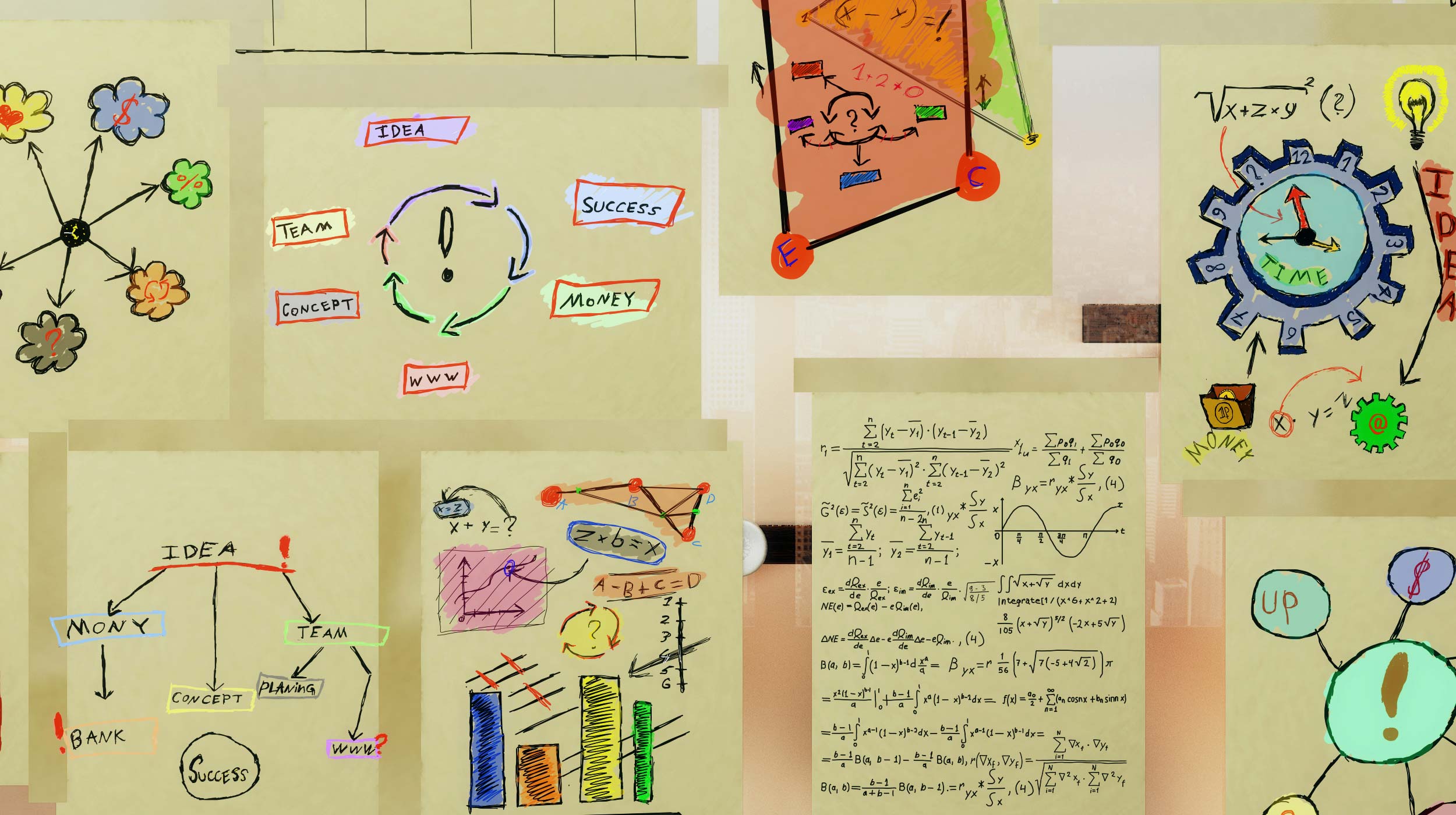If your brainstorming sessions fall flat, you’re not alone. Many of the clients we talk to say their brainstorming often devolves into chaos and generates few useful ideas.
The issue isn’t that brainstorming is useless or past its prime. It’s that most groups don’t conduct these sessions effectively. They don’t put enough effort into planning and definition and instead focus exclusively on random, ill-defined free-association.
In this article, we’ll look at the evolution (or devolution) of brainstorming over the years, the benefits marketers can enjoy from effective ideation and how to conduct more productive sessions.
What is brainstorming?
Brainstorming goes all the way back to before World War II. That’s when pioneering advertising executive Alex F. Osborn came-up with a novel way to break through creative blocks. His employees were unable to come-up with fresh ideas for ad campaigns, so he began hosting group-thinking sessions. He found that they increased the number and quality of ideas generated by his creative team.
It took Osborn almost ten years to outline his concept in the book Your Creative Power.
His approach focused on two principles that were highly innovative at the time:
- Don’t judge anyone else’s contributions or ideas
- Generate a large quantity of ideas rather than a few.
Under these two principles, he encouraged the following three behaviors:
- Reduce social inhibitions among the people in the group. This was truly revolutionary at the time. It was a period in history when judgement governed most social interactions.
- Stimulate idea generation. This was another novel concept for the era. People living in the middle of the last century didn’t have all the creative stimulus we do today. They had radios, listened to records, went to movies and television was in its infancy. There was no social media, cable or internet to get creative juices flowing.
- Encourage creativity within the group. This was a big innovation. Osborn was working in the era prior to the explosion of creative expression that began in the 1960s.
Osborne used four rules to manage his brainstorming sessions:
- Promote quantity over quality. This was perhaps Osborn’s biggest innovation. People in the 1930s and 40s were more one-dimensional than we are today. They generally focused on a single good idea and saw it through to realization. Osborn believed that having many concepts to work through provides more opportunities to find the one truly great and innovative idea.
- Discourage criticism. Osborn frowned on criticizing ideas during brainstorming. Instead, he believed people should feel free to express themselves and build on their ideas, reserving judgement for later. This gives the people doing brainstorming a safe space to generate unique and unconventional concepts.
- Encourage wild ideas. Osborn asked participants in his brainstorming sessions to “go wild” and suggest crazy things that suspended traditional assumptions. This was a big departure in a period when conventional thinking was the norm. It was a giant leap to believe that unusual perspectives could lead to better solutions.
- Combine ideas to expand on them. In his sessions, Osborn pushed people to mix one or more ideas into something bigger. He found that combining a few small concepts often turned them into something much bigger than the sum of their parts.
Osborn always made sure each of his brainstorming sessions addressed a single specific issue. Taking on too much proved to be ineffective. He also insisted that his brainstorming technique only be used when generating new ideas was the goal, not judging or evaluating concepts.
He also preferred that meetings include diverse groups of people. He limited them to no more than a dozen participants. This let him uncover diverse perspectives while keeping the sessions manageable.
Osborne made it a point to document and share results with participants and communicate how the ideas were used in the marketplace. This helped his “brainstormers” feel their ideas were valued and the time they put into generating them was worthwhile.
Why did brainstorming fall out of favor?
Osborn came up with a highly disciplined approach to ideation that was governed by rules. It was designed to encourage free thinking and association at a time when these were novel concepts.
Unfortunately, over time, brainstorming lost its rigor and reason for being.
Brainstorming sessions often became free-for-alls with no clear purpose. In addition, as society evolved and free association became more common, brainstorming was viewed as a quaint concept that seemed less relevant. Also, leaders of brainstorming sessions often stopped reporting back to participants, which left them feeling that they had wasted their time.
Perhaps the biggest factor that damaged brainstorming was ineffective moderation. Poor facilitators often let the following things happen:
- Blocking: If a moderator spends too much time on one participant’s idea, others forget their ideas or decide not to share them because they feel their ideas don’t have value. A good facilitator will keep a brainstorming session moving so concepts aren’t forgotten or de-valued.
- Conforming: If the facilitator isn’t careful, “group think” can take over and some people in a session may conform their thinking to the patterns of the broader group. It’s a smart move for a moderator to constantly probe for fresh perspectives.
- Free-riding: Like many other team endeavors, some members of a brainstorming team may hang back and let others do the heavy lifting. A good moderator stays aware of free-riders and actively engages them in the process.
- Dominating: Extroverts often take-over brainstorming sessions, leaving thoughtful introverts in the dust. A good moderator finds ways to balance these two personality types.
- Matching: This phenomenon happens when participants with a lot of ideas hold back to match the slower pace of the broader team. A moderator should encourage participants to share all their ideas, no matter the dynamic of the broader group.
These are just a few of the issues that tainted the concept of brainstorming.
Is it time to bring brainstorming back?
Today, concepts like free association, attention deficit, and lack of focus are a regular part of everyday life. So it would seem counter-intuitive that it’s a good time to bring back brainstorming. However, the discipline behind Osborn’s original concept — or newer approaches like Smartstorming — could provide the structure needed to make ideation productive again.
Instead of solving the problem brainstorming was invented to solve, which was encouraging creative thinking in a restrictive era, today it could be used to govern the ideation process to keep it focused on generating usable concepts.
How to bring value back to brainstorming
In addition to going back to Osborn’s original four rules of brainstorming, here are some things you can do to refresh your brainstorming sessions and make them valuable modern marketing tools:
- Pick a qualified moderator. As discussed earlier, a mediocre moderator can stifle a brainstorming session. Pick someone who can keep ideas flowing in a fair and balanced way with no judgements. They should be authoritative and respected to keep the brainstorming process from going off the rails. Make sure
the facilitator isn’t too invested in the solution, so they’re open to letting the ideas of others shine. If you don’t have someone on your team who can play the role, go outside to find someone who’s qualified. - Set a clear goal. Make sure the moderator is able to clearly articulate the goal of the brainstorming session. If they can’t, spend extra time defining it. Having a brainstorming session without a goal is a lot like taking a trip without knowing the destination. The goal of your brainstorming session should be a SMART one, meaning it must be: Specific, Measurable, Attainable, Relevant and Time-Bound.
- Set a time limit. Your brainstorming session will be more effective if the participants know when it’s going to end. Doing so will prevent people from holding back on sharing their ideas for a later time and will keep the process on track. The length of your session depends on the scope of the challenge you’re taking on. However, many people tend to burn out after ninety minutes of creative thinking. If you need more time, provide breaks or divide the session over multiple days.
- Assign a scribe. It’s important to document all the ideas generated during a brainstorming session. After all, coming up with ideas is the reason for conducting the meeting. Have sketchpads, post-its and whiteboard space readily accessible. Take smartphone photos of any ideas you can’t physically take back to your office.
- Eliminate the weak link. If someone at your brainstorming session is making negative comments or seems to be sharing biased or self-serving ideas, take the person aside and ask them to change their attitude or leave. When it comes to brainstorming, one bad apple CAN ruin a session.
Interested in taking your brainstorming to the next level? Start by taking time to read the valuable book Smartstorming. It offers valuable insights on how to do brainstorming right. As a next step, contact Carpenter Group, an agency that has experience managing sessions for some of the best-known firms in the financial and professional services industries and leveraging the insights gained from those meetings. We’ve helped firms take their businesses to the next level through creative ideation. We can be the strategic partner that guides you and your team to fresh strategic and creative ideas.




